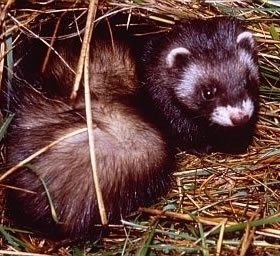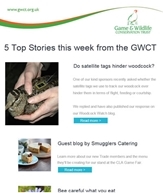By Jonathan Reynolds, GWCT Head of Predation Control Studies
Main points
- A new report shows that polecats have recovered much of their original range in England and Wales.
- Where true wild-type polecats have encountered feral ferret populations, the wild-type is gradually becoming predominant.
- Within the geographical range of polecats, the risk of capture in tunnel traps cannot be ignored.
- It is an offence to set a trap that is likely to injure or kill a polecat that comes into contact with it. The offence is to set the trap, not to catch a polecat. Landowners and employers who cause or allow such an offence are also culpable.
- We recommend the use of excluders on trap tunnels to be sure of not committing this offence.
 New report
New report
The Vincent Wildlife Trust has just released a report on its recent survey of polecats in Britain (available for free download from the VWT website). This is an elegant example of ‘citizen science’ adding to our knowledge of Britain’s mammals. VWT invited members of the public to send in records of polecats during 2014-15.
The report by Elizabeth Croose especially focusses on 740 submissions that were verifiable (photos and carcasses), although in fact the further 1,021 unverified reports largely supported the emerging picture of distribution, rather than introducing uncertainty.
Distribution maps drawn from the 740 verified records indicate how the polecat has continued to spread across the country since the last survey in 2004-2006. Wild-type polecats are now to be found throughout Wales, the Midlands and into Lincolnshire and East Anglia, in the south-west peninsula, throughout south central England and in parts of the south-east.
Polecats are well established in Cumbria, where they are understood to have been released in the 1960s-80s, and likewise in Perthshire and Angus. Their presence in Dumfriesshire probably represents expansion of the Cumbrian population.
History
Polecats were originally present throughout Britain, but were heavily affected by man during the 19th century, to the extent that by 1915 polecats were essentially confined to a small patch of Wales. The blame for this decline is often placed on gamekeepers on shooting estates, but this is arguably unfair.
The widespread use of gin traps in harvesting rabbits is likely to have had a very heavy impact on polecats. The rabbit industry (for meat, felt and glue) had been developing since the Ground Game Act 1880. In our post-myxomatosis days the scale of it is now largely forgotten. Shortly before gin traps were outlawed by the Pests Act in 1954, the harvest was about 40 million rabbits per year.
Polecats were given partial legal protection in 1981. By the time of the last polecat survey (also by VWT) in 2004-6, polecats had recovered appreciably, consolidating their range in Wales and the borders, expanding throughout the west- and southwest-Midlands, and into central southern England.
Ferrets
A ferret is simply a domesticated polecat. In general, domestication selects for characters that make animals easier to handle, usually at the expense of their viability in the wild. Very often domesticated animals have coat colour characteristics that mark them out from the wild-type colouration.
This may have made them easier to distinguish, but it is also because coat colour is genetically linked to (i.e. inseparable from) other characteristics that are probably more relevant than colour to the animal’s survival in the wild. For this reason, feral populations of domesticated animals tend to revert back to wild-type colouration over time – mink in Britain are a good example.
There are many colour variants of ferret, the commonest ones being albino, sandy, and what is termed ‘polecat’, with many intermediate types. The ‘polecat’-coloured ferret is very similar in appearance to the wild-type polecat, but in individuals the pattern of facial markings often betrays domestic origins.
Other physical differences (e.g. paw size) may be under genetic control but may equally be acquired through life in the wild. Under the surface, the hidden consequences of domestication include a reduction in brain size.
In the VWT report, animals that had no visible characteristics of domesticated ferrets (i.e. were ‘wild type’ colouration) were classified as ‘pure’ polecats. The current range of the species was classified into bands according to the prevalence of ‘pure’ polecats.
There was a recognisable trend for increasing ‘purity’ towards the historic stronghold in Wales, but also for increasing prevalence of wild-type polecats in areas that formerly held only feral ferrets.
Legal status
The polecat is on Schedule 6 of the Wildlife & Countryside Act 1981 (WCA), and therefore Section 11 of the Act applies to it. The feral ferret is not on any Schedule, hence there is some uncertainty about the legal status of feral ferrets. In some regions, populations exist that have originated from escaped ferrets.
Arguably, it is lawful to deliberately trap and kill these animals, although this has never been an entirely certain case. As the VWT survey shows, the expanding wild polecat population is now in contact with those feral ferret populations in several regions, and as expected the domesticated characters are steadily disappearing.
Legal situation on trapping and polecats
We are not qualified to give legal advice, but the following is our understanding of the legal situation. In England & Wales (WCA, 1981, Section 11), you must not set a trap that will cause bodily injury or death to any Schedule 6 species that comes into contact with it, either due to the nature of the trap, or because of the way you used it.
Setting traps for lawfully-trapped species is accepted provided you take “all reasonable precautions” to prevent injury to Schedule 6 animals (pine marten, otter, red squirrel, water vole, hedgehog, polecat).
So with Schedule 6 species like the polecat the offence would arise when you set a trap, whereas with Schedule 5 species (pine marten, otter, red squirrel, water vole) the offence is to actually catch a protected species. (Some species are on both Schedules.) The polecat is not on Schedule 5, and therefore it remains lawful to kill or take them by any method that is not forbidden for other reasons.
So shooting a polecat is lawful, and in some emergency situations (e.g. to protect poultry or pets) this is an available option that does not require any special licence. Deliberate use of traps to target a polecat would always require a licence from Natural England.
Under the 1991 amendment to the WCA, the landowner/employer would also be guilty of an offence if they knowingly caused or permitted it. The trap user must be shown to have committed an offence, at which point the landowner/employer could also be prosecuted.
Legal status of hybrids
The legal status of feral ferrets and ferret-polecat hybrids is uncertain, and has not been clarified by case-law. The WCA states that a captured animal must be assumed to be wild unless it can be proved otherwise. A trap capable of killing or injuring a ferret would clearly be equally capable of killing or injuring a polecat.
The VWT report shows that where the expanding polecat distribution has met and mingled with feral ferrets, domesticated characters are in decline. So in some regions it may have been legitimate to set traps to catch suspected feral ferrets, but this is becoming an indefensible argument.
What to do
If you are using tunnel traps within the range of the polecat indicated in the VWT report (or if other Schedule 6 species are present and at risk of capture), we recommend that you either use excluders (see below) at each open end of the tunnel, or use live-catch traps (wire cage traps or wooden see-saw traps).
If you have a particular need to reduce grey squirrel or rat numbers, then we recommend that you specifically target these species with a cereal bait, using pre-baiting to concentrate the catch into brief periods of intensive kill-trapping in tunnels without excluders. We believe this would be accepted as having taken ‘reasonable precautions’ to avoid catching Schedule 6 species.
These solutions involve a shift away from the concept of a universal tunnel trap aimed at a suite of common small predator or pest species. This shift may be necessary for other reasons too. The recent debate about trap humaneness has highlighted the difficulty of finding trap models that are demonstrably humane for a spectrum of pest species.
A consequence has been that recent approvals of new trap models have been for more limited lists of target species than was the case in the past, while approval for stoats may be removed from some established trap models in the near future.
Excluders
Back in 1998-9, GWCT developed an ‘excluder’ design for trap tunnels. This consisted of vertical wooden dowels set in a wooden frame measuring 20 x 19 cm, although it could be made of other materials. The spacing of the dowels was carefully tested with captive animals to exclude protected species (polecat, pine marten, hedgehog), while allowing stoats and weasels to enter easily.
The critical dimension is that no gap should be more than 32.5 mm wide. Trials by gamekeepers showed that weasel and stoat captures were undiminished. The excluder did, however, reduce catches of the larger grey squirrels and rats, conflicting with the customary use of tunnel traps as ‘universal’ pest traps.
Our recommendation at the time was therefore that the excluder be used at the discretion of the operator, where there was a recognisable risk of catching protected species and thereby committing an offence. This remains our advice today. If you are unaware of polecats in your area, the distribution maps published by VWT should be your guide.
Is trapping a problem for polecats?
The ongoing spread of polecats shows that trapping – whether accidental or wilful – is not currently a major barrier to recovery. However, the VWT report does express a concern about what will happen as polecats start to expand into areas with high intensities of trapping or gamebird releasing where conflicts of interest might occur more frequently.
We hope that as wildlife conservationists the shooting community will recognise that they share responsibility for all our native mammals. Rightly or wrongly, the gamekeeper carries the blame for the near extinction of polecats a century ago, so there is historical baggage to live down.
The purpose of Schedules 5 and 6 of the WCA is to protect species whose conservation status is damaged or vulnerable. There may well come a time when the inclusion of polecats in Schedule 6 is no longer justified on conservation grounds. Under the present arrangement, we advise trap users to protect themselves against possible charges by using excluders on trap tunnels.
 Free weekly newsletter
Free weekly newsletter
Stay updated on this story and get all the latest GWCT blog updates and news delivered straight to your inbox each Tuesday.
Sign up FREE to the Weekly GWCT Newsletter >